Biennale 08
Completed the last part of the bi-annual Biennale yesterday. The theme for this year’s biennale is WONDER. Wonder calls us to question and be curious. Yet at the same time, to let ourselves be surprised, awed, tantalised and challenged.
The selection at this biennale this year does not disappoint. There are a tapestry of ideas, styles and medium presented. Every work is highly original and stands on its own as a work of art. Laudable are the high standards of the selected exhibits, and their ability to provoke and inspire.
However, many of the single-channel video installations fail to spark any interest. Many videos come across as monotonous and deadpan boring. Aktan Abdykalykov’s Beket(Bus stop) comes across as making something out of nothing; His video records people waiting at a bus stop and how people react to certain disturbances at some time in the video.
Another work is Suha Shoman’s “Stop for God’s Sake”. She “tells the story of the Palestinian people,. .. reflects on the message of tolerance among the three monotheistic religions which are contradicted by this tragic reality.” She uses footages of the death and destruction of the arab-israeli wars, n excerpts from catholic, muslim and jewish religious ceremonies. She tackles war, death and religion all at one go. Many of the issues lose their edginess, their inert complexities and sentivities. The result is an ambitious but premature work. The use of excerpts from Fauré and Mozart’s Requiems as sugar coatings complete the cliché.
Sherman Ong’s Benjir Kemarau (Flooding In the Time of Drought) is a much more interesting piece of work. Ong filmed conversations between immigrants in Singapore. The lack of water in Singapore serves as a backdrop to their anxieties, pains, joys and struggles of working in Singapore. The many conversations are thought-provoking in their own right, but there are few with the patience to sit through the entire video, estimated to be at least 60 mins long.
Soren Dahilgaard’s Breathing Room is pretty overhyped. Basically a very claustrophobic room that ‘breathes’, the ‘breathing mechanism’ is pretty contrived. The idea’s pretty much there, but the illusion of a non-living space that “breathes” organically doesn’t really succeed.
That being said, here now are my top 5 of this year’s biennale, in order of merit. 5 being the best.
1. Who is this Family, Rachel Goh
She has asked her family to re-enact the poses and demeanor of a family photograph taken twelve years ago. They swapped positions and respective clothes in a clockwise manner and a new set of 5 family portraits were taken. The position of the head of the family for example, will be occupied by rachel in one photo, her brother in another, n her mother in yet another, and so on. It illustrates the changes in relationships between the family members as time progresses. I discovered how people relationships in the army are constantly changing myself around the same time as i heard of this work. Rachel’s work was a lesson in how a complex idea could be expressed in such a lucid manner. Her final idea was pretty resolved, with a hint of humour.
2.Raw Canvas, Jane Lee
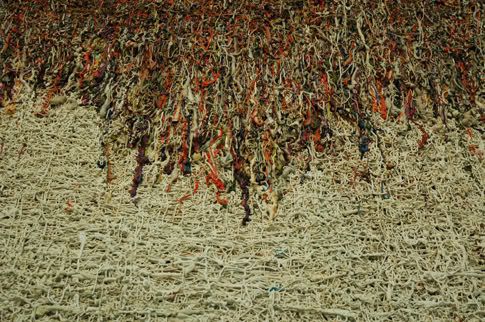
The hard work and dedication injected into this work speaks for itself. The size of the work is overpowering, and the rich textural qualities induce many to want to reach out their fingers to touch the dried paint.
3.The wreck of men, Charly Nijensohn

This is my favorite work in the entire biennale. This is Salar de Uyuni in Bolivia, a vast salt desert 13,000 ft above sea level. When Charly went there, the sky meets an almost perfect reflection of itself, creating an extraordinary mirrored horizon. There are lone people who stand alone admist small islands of rocks. The natural colours in the film are hautingly beautiful, with hints of Romanticism. A very meditative and spiritual work. The wonder stems from the awareness that these are real people an real places. Such a place exsists in this world.
4. Singapore,Wit Pimkanchanapong
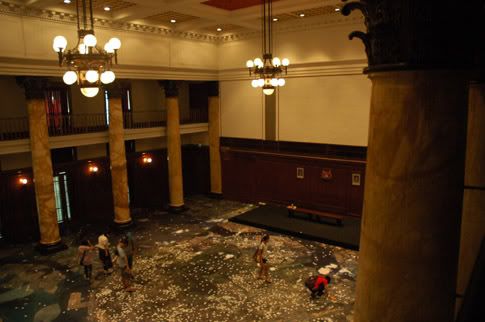
He has filled the entire city hall chamber with a google earth aerial rendition of the entire island. Viewers are allowed to walk freely over the work, and paste notepads on the work n scribble anything on them. Its a pretty interactive work n it becomes very personalized as individual messages, layer by layer, build up in such a historic chamber.
5. Hair Salon, Leandro Erlich
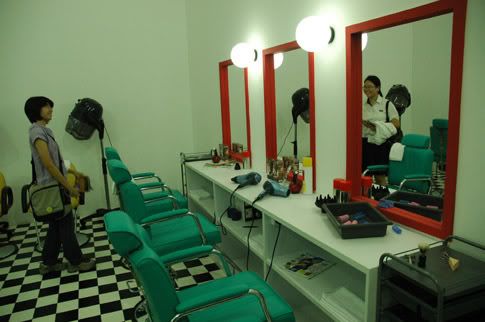
He has created the interior of a beauty parlour inside an old room in the South Beach Development. Stumbling across his work in the building, n studying the opening hours printed on the glass doors is a kind of revelation. A surreal fantasy, inspiring bewilderment and confusion; How come got parlour in this old army building one? Only to discover that it is another art installation.
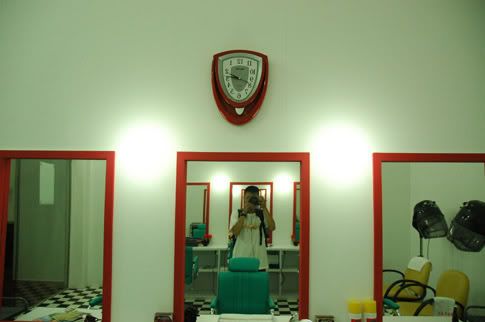
Then the confusion again. The installation is devised so that when you look into the mirror on the wall, it appears as if the room is reflected in the mirror, but in fact, there is an identical room that has been reflected symmetrically behind the mirror.
Quasi-orgasmic, semi-magical, when u put ur hand ‘through’ the ‘reflection’. Into a symmetrical reality. Walking around in the identical room is a step into a Magrittian therapy session. Kudos to the artist for sweeping u off ur feet for a few seconds, only to return pleasantly surprised.
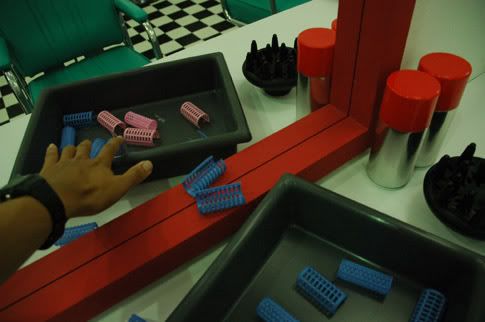
On the whole, many of the installations flunk not because they are uninteresting. They score on concept and creativity, but expectations fall short due to lack of refinement and attention to detail. At the other end of the spectrum are masterpieces like Hair Salon that catch you off guard. This year’s biennale is a must see for these mini-masterpieces. As you pause that think about the processes behind the work, reflect on what they mean to you, and remember the moments that stirred something in you long after you have left the exhibition. Its only at that point that everything else seems to cease, and you truly, wonder.
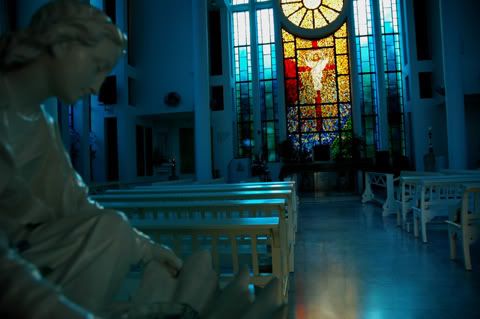
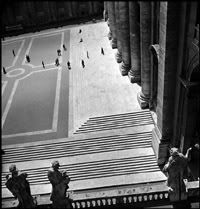










<< Home